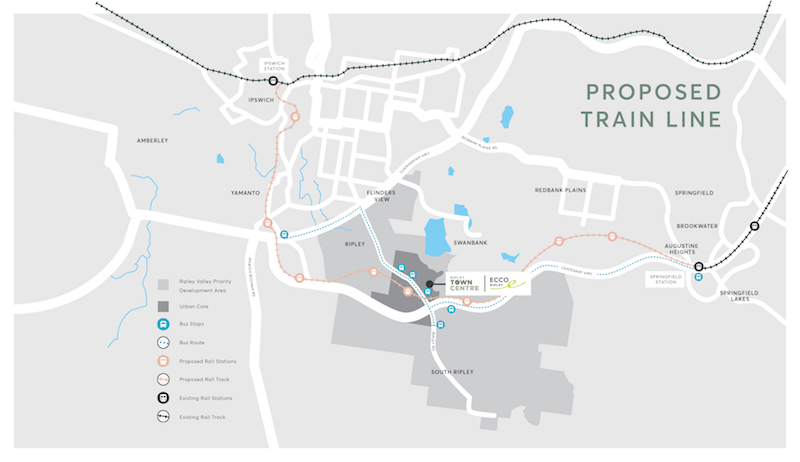Connectivity is key to transforming the Ripley region over the next decade, with Ripley Town Centre at the heart of a 25-kilometre public transport corridor from Ipswich Central to Springfield Central, providing residents with affordable access to surrounding communities and ensuring new cities are being built, not just sprawling suburbs.
The timely provision of the rail extension is vital to lead and sustain communities in the Ripley Priority Development Area (PDA).
This critical “enabler project” will seamlessly link the region and provide much-needed connectivity in one of Australia’s fastest growing areas.
Ipswich City Council has released a strategic assessment to support the Ipswich Central to Springfield Central Public Transport Corridor (I2S Corridor), with an options assessment expected to follow with state government backing.
Ipswich City Council mayor Teresa Harding said it was important that growing residential communities stay connected to jobs, health care services, education and recreation options.
“The I2S Corridor is vital infrastructure of national significance and we cannot afford to delay its progression any further,” Harding said.
“If the project does not proceed, excessive congestion will cost in excess of $1 billion per annum and the regional road network will fail by 2031.
“We need state and federal government support to continue to enable the progression of the project to the options analysis stage, which Council estimates will cost approximately $2.5 million.
“The I2S Corridor will undoubtedly shape south-east Queensland and the state more broadly.”
The I2S Corridor is considered the region’s highest priority infrastructure project to meet the needs of future population growth.
The proposed rail line includes plans for nine new stations in total, connecting to the existing Springfield Central line and travelling west via Redbank Plains, Swanbank, Ripley Valley Town Centre, Ripley North and Deebing South before continuing north through Yamanto, Berry Street, One Mile, the University of Queensland Ipswich Campus and the Sadliers Crossing terminus station in Ipswich.

Federal member for Blair, Shayne Neumann MP said the project presents an opportunity to deliver a public transport solution that addresses current and emerging growth across the region.
“The rail extension will link the three fastest growing suburbs between Brisbane and Ipswich—Springfield, Redbank Plains and Ripley,” Neumann said.
“It’s the missing link—crucial for the growth of the region.
“There needs to be greater government investment on infrastructure projects like this one for the purposes of job creation and economic development.
“You can’t build a community without the necessary transport infrastructure, otherwise you just end up isolating people and we’ve seen enough of that recently.”
Sekisui House Australia project director Taku Hashimoto said the delivery of a public transport solution for the growing community of Ripley and the surrounding areas now, will ensure the opportunities for integrated land use development are maximised, especially along the I2S Corridor.
“The rail extension is transformative city-shaping infrastructure,” Hashimoto said.
“Ultimately, the rail is critical to the future of the Ripley region and south-east Queensland with population growth in this corridor already among the highest in Queensland.
“Without the rail, you just end up with a sprawling suburb instead of what was planned — a pattern of unique settlements that drive economic opportunities for the people who live in the area and the businesses that operate here too.”
Ripley is considered one of Australia’s major growth areas. The suburb’s population is projected to increase at a rate of 27.6 per cent each year until 2026 and the broader Ripley Valley region will see approximately 133,800 new residents by 2036.
Proactive infrastructure provision is essential to ensure expensive, retrospective infrastructure solutions to service emerging communities are avoided with early provision of a rail line service critical to support the region’s fast-growing population.
“The rail will offer the community affordable transport choices that improve people’s access to services, employment and education,” Hashimoto said.
A Ripley Valley 531 bus route was also introduced in 2019 as part of a five-year, $6.6 million investment by the Queensland Government, acknowledging the need for transportation options outside of already congested local roads.
With technology and policy shifts also dramatically changing the way people move now and in the future, Ripley Valley’s strategic transport system—roads and public transport—will need to be strongly connected.
This not only benefits users in the short-term but provides a much more resilient region in the longer-term.
The enhanced public transport offering will also contribute to the preservation of the Ripley region’s social fabric and provide a fast-growing population with a much-needed alternative.
The proposed I2S Corridor rail extension, will play a critical role in shaping the future of this booming region.
Ripley really is the missing link.
The Urban Developer is proud to partner with Sekisui House Australia to deliver this article to you. In doing so, we can continue to publish our free daily news, information, insights and opinion to you, our valued readers.